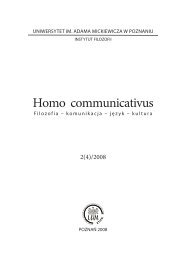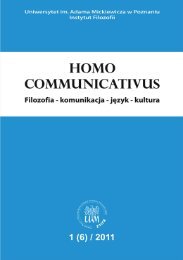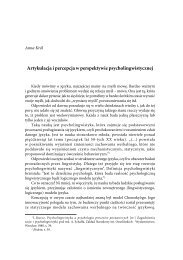74MARIETTA RADOMSKAZoosemiotics as an interdisciplinary studyHaving drawn basic distinctions between the latest sub-disciplines of semiotics,we may proceed to the issue of zoosemiotics introduced to scientific world by theabove-mentioned American linguist, semiotician and of course zoosemiotician,Thomas A. Sebeok, who defined it in his work Perspectives in zoosemiotics (1973)as “the discipline within which the science of signs intersects with ethology, devotedto the scientific study of signalling behaviour in and across animal species. Thebasic assumption of zoosemiotics is that, in the last analysis, all animals are socialbeings, each species with a characteristic set of communicaton problems to solve.” 10Apart from the definition by Winfried Nöth quoted at the very beginning of thispaper, we may refer to the one stated by Giuseppe Malacarne (in: DaniloMainardi,Dizionario di etologia, Torino: Einaudi, 1992) 11 : “zoosemiotics deals withthe rules of animal communication by using the theory of information(e.g. mathematic analysis of signals) and the theory of communication. Situatedbetween traditional ethology and sociobiology, it deals with topics of particularinterest: 1) the nature of communicative channels (visual, tactile, electric…) inrelation with the environment; 2) the meaning of a message in relation with thecontext in which it is emitted; 3) the ability of social species to construct symboliclanguages. The latter shows similarity between zoosemiotics and cognitiveethology.” In fact zoosemiotics fails to be conceived as a discipline with scientificautonomy and full-rights status, especially when compared with other kinds ofstudies within semiotics, such as biosemiotics or musical semiotics. However,zoosemiotic research has been conducted by scholars belonging to a variety ofdisciplines, for instance: Heini Hediger, famous zoologist and animal psychologist,or Marc Bekoff, ethologist.This brings us to the point of another distinction – according to Dario Martinelli– between: ethological zoosemiotics, divided into traditional current, representedby early Sebeok, Lindauer, Lorenzian or behaviouristic traditions and the cognitiveone (latest Sebeok, Cimatti and Bekoff); and anthropological zoosemioticsconsidering semiotic interaction between human beings and other animals,including both cultural and/or sociological genre. Yet we appear to concentrate onthe latter, consisting of two sub-categories as well: communicational one referringto human – non-human animal interaction of a communicative type, i.e. intentional,reciprocal and interactive; and significational type. According to HonorataKorpikiewicz 12 , what is important is to conduct the research on the issue ofunderstanding and correct interpretation of cause and effect by non-human10Dario Martinelli, Seboek 2.0, on website: http://www.zoosemiotics.helsinki.fi/intro.<strong>pdf</strong>11Ibidem.12Honorata Korpikiewicz, Porozumienie ze zwierzęciem, in: Honorata Korpikiewicz (red.),Człowiek, zwierzę, cywilizacja, Prodruk, Poznań 2001, pp. 35-53.
ZOOSEMIOTICS AS ...75animals, as well as the way they perceive the cause of phenomena. Still, sheemphasizes the ethical and methodological aspect of such observations, whichshould be made outside the laboratories, in the natural environment.However, anthropological zoosemiotics of communicational type substantiallyconcentrates on interspecific communication experiments but includingsimultaneously e.g. human – pets or human – cattle interaction. In accordancewith such kinds of experiments, let us mention great apes projects, for instanceGorilla Language Project with its main actor: female gorilla named Koko who hasa working vocabulary of over 1000 signs of American Sign Language andunderstands approximately 2,000 words of spoken English 13 . Apart from thescientific aspect Koko.org is also a foundation raising money for better, i.e. humanetreatment of captive animals and increased conservation efforts for those that arefree-living. Although the experiment entails some ethical doubts (whether we havethe right to make Koko – or any other animal - “more human” than she is), it hashelped to change some people’s stereotyped attitude towards animals, theirpossession of feelings, thought processes, imagination and , moreover, to giveawareness of the necessity of the prevention of cruelty to animals as well asconservation and preservation of endangered species.Passing on to the second branch of anthropological zoosemiotics(significational), one is able to see the difference: here non-human animal itselfis a pure source of meaning. Therefore, it has become the object rather thana subject of signification, frequently in myths, tales, as allegories but also inclassifications e.g. taxonomy. If we understand ecosemiotics as the study of humanrepresentation of nature, we can thus treat this model as an ecosemiotic one.Indeed, we appear to observe another distinction: whereas ethologicalzoosemiotics has a close relationship with natural sciences, the anthropologicalis broadly connected with social sciences, also anthrozoology. In consequence,we can see that zoosemiotics is an interdisciplinary study occupying intermediaryposition between natural and human sciences.For the purpose of this paper it seems necessary to make a brief reflection onthe concept of animal, broadly discussed in the significational area ofanthropological zoosemiotics. Still, devoid of any reference to the definitions 14 of“animal” stated in dictionaries. What appears to be significant all scientificallyacknowledgedtaxonomic classifications place “human being” within animalkingdom, yet it should not surprise anyone. As Thomas Seboek stated, “the animaleasily becomes a cultural object, a kind of information that – as a result of givensystem of socio-cultural values – determines a gap, if not a straight reconfiguration,13On website: www.koko.org14However, in each of them, the Latin origin is mentioned: “animale” standing for “living, providedwith soul”
- Page 1 and 2:
HomoCOMMUNICATIVUSFilozofia - komun
- Page 3 and 4:
Redaguje zespółRedaktor naczelny
- Page 5 and 6:
Słowo wstępnePrzed kilku laty pow
- Page 7 and 8:
Drodzy Czytelnicy,Z radością, ale
- Page 9:
Emanuel KulczyckiJęzyk a podróżP
- Page 12 and 13:
12EMANUEL KULCZYCKIrozważając asp
- Page 14 and 15:
14EMANUEL KULCZYCKIjęzykach: „Po
- Page 16 and 17:
Łukasz WiśniewskiFilozofia po Aus
- Page 18 and 19:
18ŁUKASZ WIŚNIEWSKIdrodze ,,rozum
- Page 20 and 21:
20ŁUKASZ WIŚNIEWSKImonarchie ich
- Page 22 and 23:
22ŁUKASZ WIŚNIEWSKIJeana - Franç
- Page 24 and 25: 24ŁUKASZ WIŚNIEWSKItylko jedną,
- Page 26 and 27: 26ŁUKASZ WIŚNIEWSKIzaufał człow
- Page 28 and 29: Magadalena SkorczykSymbol, mit, met
- Page 30 and 31: 30MAGDALENA SKORCZYKo języku w kat
- Page 32 and 33: 32MAGDALENA SKORCZYKważnym składn
- Page 34 and 35: 34MAGDALENA SKORCZYKgenezy języka
- Page 36 and 37: 36MAGDALENA SKORCZYKi potrzeby. Now
- Page 38 and 39: Dominika ŁukoszekFood, pets or god
- Page 40 and 41: 40DOMINIKA ŁUKOSZEKan economic suc
- Page 42 and 43: 42DOMINIKA ŁUKOSZEKperson feels an
- Page 44 and 45: 44MAGDALENA FOŁDAkomunikację nie
- Page 46 and 47: 46MAGDALENA FOŁDAi zazwyczaj nale
- Page 48 and 49: 48MAGDALENA FOŁDAdogadują sobie i
- Page 50 and 51: 50MAGDALENA FOŁDAna to nie godzi)
- Page 52 and 53: 52MAGDALENA FOŁDAtego „jak” dz
- Page 54 and 55: Anna KrólArtykulacja i percepcja w
- Page 56 and 57: 56ANNA KRÓLdźwięków, które mog
- Page 58 and 59: 58ANNA KRÓLartykułowane niestaran
- Page 60 and 61: 60ANNA KRÓLneuroakustycznym. Dalej
- Page 62 and 63: Juliusz IwanickiKultura materialna
- Page 64 and 65: 64JULIUSZ IWANICKI• panowanie bry
- Page 66 and 67: 66JULIUSZ IWANICKIwarunków do harm
- Page 68 and 69: 68JULIUSZ IWANICKITak więc, w świ
- Page 70 and 71: 70JULIUSZ IWANICKIMimo wszystko, dy
- Page 72 and 73: 72MARIETTA RADOMSKAexpectations”
- Page 76 and 77: 76MARIETTA RADOMSKAbetween signifie
















